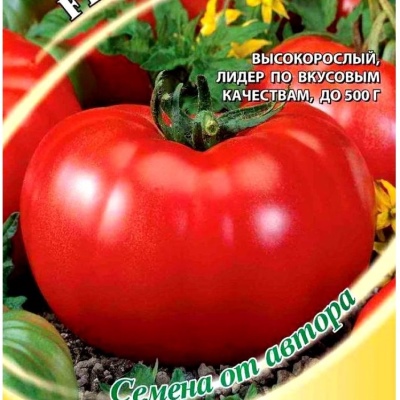
- Authors: Gavrish S.F., Morev V.V., Amcheslavskaya E.V., Volok O.A., Gavrish F.S.
- Year of approval: 2002
- Category: hybrid
- Growth type: indeterminate
- Appointment: fresh consumption, for pickling and preserving
- Ripening period: early
- Ripening time, days: 108-115
- Growing conditions: for film greenhouses
- Marketability: high
- Transportability: Yes
For summer residents, whose backyard plots are very small, it can be problematic to choose a high-yielding type of tomato, since most plants take up a lot of space. The tomato variety Kirzhach belongs to the compact, high-yield, and does not require complex agricultural technology.
Breeding history
A group of Russian breeders (Gavrish, Morev, Amcheslavskaya and Volok), representing the Gavrish agricultural company, worked on the creation of this type of tomato. The variety was created in 2000, in 2002 the culture was entered into the State Register of Breeding Achievements of the Russian Federation, and also allowed for use. The variety is recommended for cultivation in many climatic zones of the country - from the Central to the Middle Volga regions. The best yield results for the Kirzhach nightshade crop are observed when grown in film greenhouses, but in open ground the plant also bears fruit well.
Description of the variety
The hybrid plant Kirzhach is a medium-sized indeterminate bush that grows up to 150-160 cm.The bushes have a strong main stem, high thickening with large foliage of a dark green color, a powerful root system prone to branching, due to which the plant receives additional nutrients, as well as inflorescences of a simple type. The first inflorescence is formed above the 9-11 leaves. The strong stem and branches do not bend under the weight of the fruit, and they are also not prone to deformation.
In each fruit cluster, despite its compactness, up to 5-6 ovaries are formed. The plant requires the obligatory formation of 1 stem, a garter to the supports, which ensures a constant air flow. In addition, do not forget about the periodic removal of new stepsons.
The main qualities of the fruit
The Kirzhach tomato belongs to the class of large-fruited tomatoes. On average, the fruit gains a mass of 131-147 grams. The berries have a regular, flat-round shape and deep red color at the stage of full maturity. When unripe, the tomato is light green in color without a dark spot at the base. The skin of the berry is thin but strong, protecting the tomato from cracking. The surface of the tomato is even, smooth and shiny. Tomatoes tolerate transportation well and are endowed with an average keeping quality - up to two weeks in a cool place.
Taste characteristics
The high taste of ripe fruits is one of the advantages of the hybrid variety. On the palate, there is a slight sweetness with a noticeable sourness, complemented by a bright, spicy aroma that every tomato has. The flesh of the berry is fleshy, dense and very juicy, with few seeds. Sometimes a thin white rod appears inside.
This variety is versatile, therefore it is eaten fresh, canned, pickled, as well as processed into dressings, sauces, pastas.
Ripening and fruiting
Tomato Kirzhach is a representative of early maturing nightshade crops. From the appearance of full shoots to the ripening of the first berries, 108-115 days pass.This makes it possible to grow the variety in regions with short summers. The active phase of fruiting is slightly prolonged, but the fruits have time to ripen before the first frost. What is important is that the plant is characterized by stable fruiting. Tomatoes ripen gradually, without crumbling at the stage of full ripeness.
Yield
The variety is high-yielding. Subject to the basic agrotechnical rules, you can collect up to 31.8 kg of tomatoes. One healthy bush yields about 6-6.5 kg of tomatoes per season.
The timing of planting seedlings and planting in the ground
Sowing seeds for seedlings is carried out in late February - early March. It is recommended to pre-disinfect the seed in a solution of potassium permanganate and treat it with a growth stimulator. You need to grow bushes in a warm room with enough light. At the stage of appearance of 1-2 leaves, a dive can be carried out (seating in separate cups).
On the eve of planting seedlings in a greenhouse or on a garden bed, it is recommended to harden the bushes, which will allow them to quickly adapt to a new place of growth. It will take 55-60 days to grow seedlings. Planting seedlings in the soil is carried out in late April - early May.

Growing tomato seedlings is an extremely important process, because it largely depends on whether the gardener will be able to harvest at all. All aspects must be taken into account, from seedbed preparation to planting in the ground.
Landing scheme
Planting density is 4 bushes per 1 m2. The optimal layout for landing is 40x60 cm.

Growing and care
It is recommended to grow a crop in cleaned, fluffed, breathable and fertilized soil. As for agricultural technology, it is standard - watering, shaping and tying bushes, removing stepchildren and lower leaves, loosening the soil, applying fertilizers, as well as mandatory ventilation in the greenhouse.




A plant needs different micronutrients at each stage of growth. All fertilizers can be divided into two groups: mineral and organic. Folk remedies are often used: iodine, yeast, bird droppings, eggshells.
It is important to observe the rate and period of feeding. This also applies to folk remedies and organic fertilizers.
Disease and pest resistance
The culture has a high immunity.It is practically not susceptible to cladosporium, tobacco mosaic virus, fusarium wilt, late blight and septoria.


Resistant to adverse weather conditions
The plant has an average resistance to stress. It is susceptible to temperature extremes and excessive heat, high humidity.

























































































